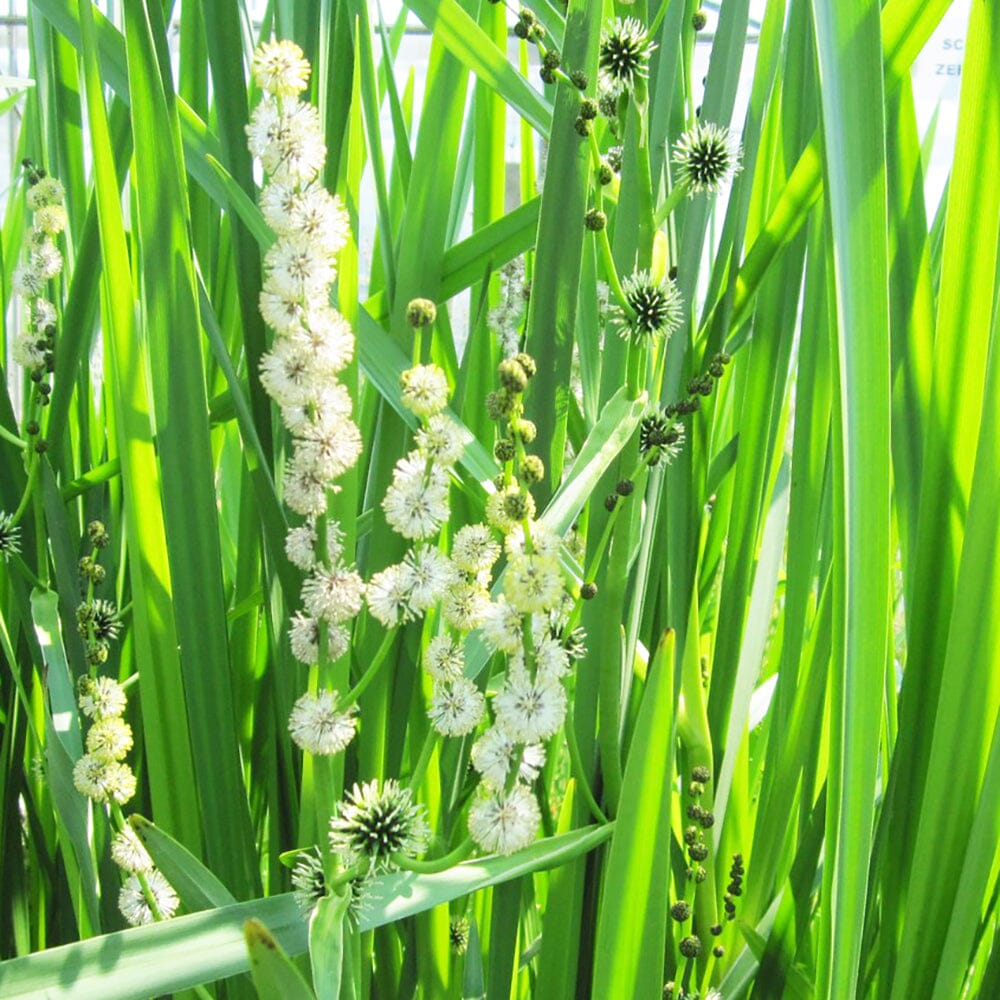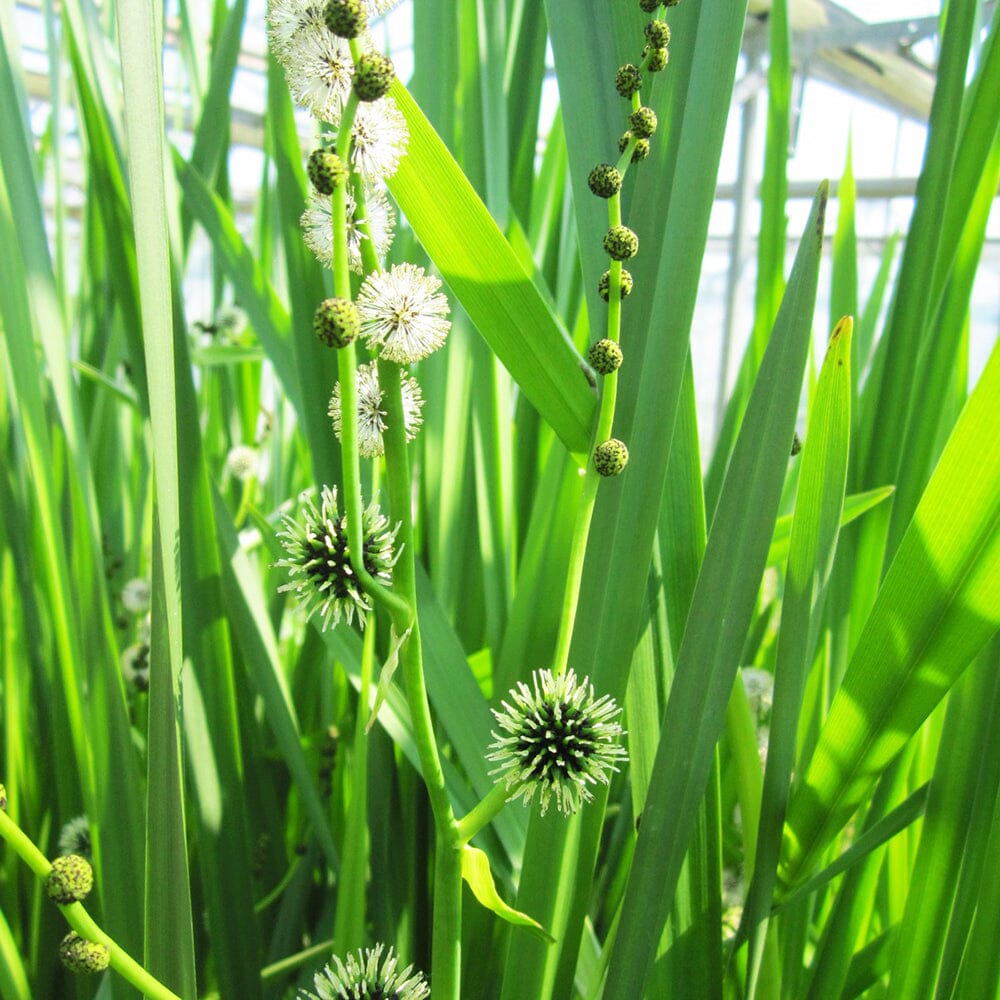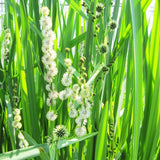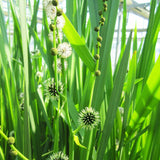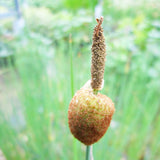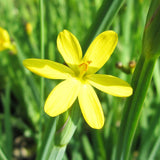Sparganium Erectum Aquatic Pond Plant - Branched Bur-reed
Sparganium erectum, commonly known as Branched Bur-reed or European Bur-reed, is a perennial aquatic plant that belongs to the family Typhaceae. It is native to Europe, Asia, and North Africa. Here's a detailed description and care guide for Sparganium erectum:
Description:
Sparganium erectum is a robust aquatic plant with erect, stout stems that can grow up to 3-6 feet (1-2 meters) tall. The stems are round, smooth, and typically have a reddish-brown or greenish-brown color. The leaves are long and narrow, often exceeding the height of the stem. They are arranged in whorls along the stem and have prominent veins. The flowers of Sparganium erectum are small and inconspicuous, arranged in dense, rounded clusters called heads. The heads are initially green and turn brown as the seeds mature.
Care Guide:
Water: Sparganium erectum is a water-loving plant that thrives in wetland habitats, such as ponds, marshes, or slow-moving streams. It prefers to be partially or fully submerged in water. Ensure that the water level remains consistent and does not dry out completely. Provide a depth of water that allows the stems and leaves to emerge above the water surface.
Lighting: This plant prefers full sun to partial shade. It can tolerate some shade but generally performs best in bright light conditions. Adequate sunlight promotes healthy growth and flowering.
Soil: Sparganium erectum is adapted to growing in aquatic environments and does not have specific soil requirements. It can tolerate a range of soil types, including clay, loam, or sandy substrates. The most important factor is to maintain a consistent water level and avoid waterlogged or overly dry soil conditions.
Temperature: This plant is hardy in USDA hardiness zones 4-9. It can tolerate a wide range of temperatures but prefers mild to cool climates. Protect the plant from extreme heat or cold, as it may cause stress or damage.
Maintenance: Sparganium erectum is a low-maintenance plant. Trim back any dead or damaged foliage to maintain a neat appearance. Remove any debris or fallen leaves from the water surface to prevent water quality issues.
Propagation: Sparganium erectum can propagate through both seeds and rhizomes. Seeds can be collected from mature heads and sown in wetland or aquatic environments. Rhizomes can be divided during the dormant season to create new plants. Ensure that each divided rhizome has sufficient roots and shoots for successful establishment.
Wildlife Value: Sparganium erectum provides habitat and food for various wildlife species. The plant's dense foliage and underwater stems offer shelter for small aquatic creatures and fish fry. The seeds are a food source for waterfowl and other birds. Additionally, the plant's fibrous roots contribute to stabilizing shorelines and preventing erosion.
Sparganium erectum is an attractive addition to aquatic gardens, pond edges, or natural wetland habitats. Its unique form and adaptability to water make it an interesting plant to cultivate. By following these care guidelines, you can successfully grow Sparganium erectum and create a thriving aquatic environment.
Selection:
Research different species of marginal pond plants to find ones that suit your pond's conditions and your aesthetic preferences. Consider factors such as height, flower colour, foliage texture, and seasonal interest when selecting plants.
Placement:
Observe the natural conditions of your pond, such as sun exposure, soil type, and water movement, and choose plants that are adapted to those conditions. Create different planting zones around the pond, with plants that prefer wet soil closer to the water's edge and those that tolerate drier soil further away.
Sunlight:
Marginal plants typically thrive in full sun to partial shade. Some species can tolerate more shade, but for optimal growth and flowering, provide them with at least 6 hours of direct sunlight per day.
Water Depth:
Determine the water depth requirements of the marginal plants you choose. Some plants prefer water up to 6 inches deep, while others can tolerate water up to 12 inches or more. Ensure that the water level remains consistent within the preferred range for the chosen plants.
Soil:
Marginal plants prefer a rich, loamy soil that retains moisture but is not waterlogged. Amend the soil with organic matter, such as compost or well-rotted manure, to improve its fertility and drainage. Avoid using heavy clay soil, as it can become compacted and restrict root growth.
Planting:
Dig a hole slightly larger than the root ball of the plant and loosen the soil at the bottom. Place the plant in the hole, ensuring that the crown is level with or slightly above the soil surface. Backfill the hole with soil and gently firm it around the plant to eliminate air pockets. Water thoroughly after planting to settle the soil and provide initial hydration.
Mulching:
Apply a layer of organic mulch around the base of the plants to suppress weeds, conserve moisture, and regulate soil temperature.Use materials like straw, shredded bark, or compost, and maintain a depth of 2-3 inches.
Watering:
Marginal plants prefer consistently moist soil but should not be waterlogged. Monitor the moisture level regularly and water as needed to keep the soil evenly moist. During hot and dry periods, provide supplemental watering to prevent the soil from drying out.
Fertilization:
Marginal plants generally do not require heavy fertilization if the soil is nutrient-rich. However, if growth appears weak or leaves show signs of nutrient deficiencies, apply a balanced slow-release fertilizer according to the manufacturer's instructions.
Maintenance:
Remove any yellowing or dead leaves to maintain plant health and appearance. Divide overcrowded plants every few years to prevent competition for resources and promote vigorous growth. Prune back excessive growth to maintain a tidy appearance and to prevent plants from encroaching on other plants or the pond itself.
Winter Care:
Hardy marginal plants can withstand winter temperatures and require minimal care. Cut back dead foliage in late fall or early spring to tidy up the planting area. In colder regions, consider protecting tender plants with a layer of mulch or covering them with burlap during winter to prevent frost damage.
Monitoring and Troubleshooting:
Regularly inspect plants for signs of pests, diseases, or nutrient deficiencies. Address any issues promptly with appropriate treatments, such as organic insecticides, fungicides, or nutrient amendments. By following these detailed tips and providing proper care, you can create a beautiful and thriving planting zone around your pond, enhancing its visual appeal and supporting a diverse ecosystem.








